I have a faux leather settee where the faux leather is flaking off leaving a fabric below. How can I restore it?
You can have it professionally reupholstered or donate it to a charity and take the market value off your income taxes and use that to buy a new settee. Call a local reupholster and ask for their advise first though. Maybe they know more than I do. :)
Go to an auto repair store. Many sell the kits to repair faux leather car seats, and sometimes you see it advertised on TV. We used it once on a car seat and it worked well. Sorry, I do not remember the exact name of the product.
Here are the questions asked by community members. Read on to see the answers provided by the ThriftyFun community.
I have a fake leather (LU) lounge which has a knife cut. It is in a non-stressed part of the fabric. However it's on a corner.
Can I join the edges back up with super glue or will this have a corrosive effect.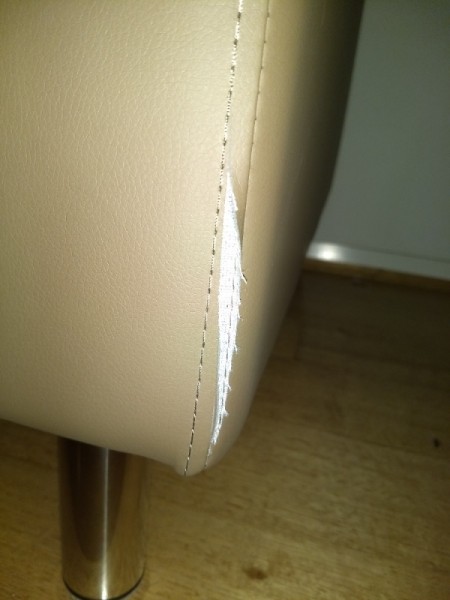
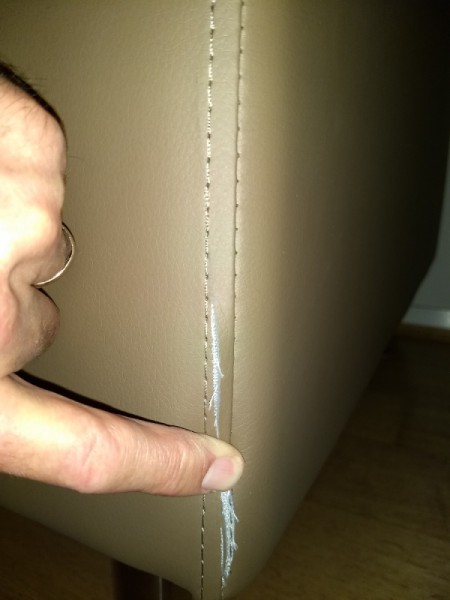
I do alterations and repair & sometimes it's on faux leather or vinyl. There is a product that is made especially for this sort of application & I've found it works very well. It's called Liquid Vinyl, and comes in a 2 oz metal tube.
I have a thin leather or "pleather" material armchair and on one arm there are several lighter marks showing. When you press down on these marks it is clear that the staples in the arm are causing these discolorations.
The staples appear to be more raised or coming out. Is there anything I can do to stop this other than taking the fabric off and removing or hammering the staples down?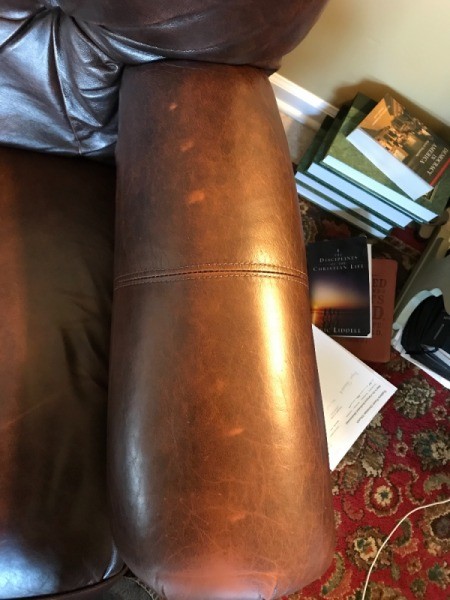
If you try and hammer the staples back in place this will damage your material on the arm. You can try and remove the under stitching of the arm material and expose the place where the staples are. Use a piece of wood to hammer them down.
I have a beautiful sofa and chair with faux leather arms and backs. The cat has made small punctures in the arms. They aren't bad, but you can feel them when you run your hand over the arm.
Is there a way to get rid of them or make them less noticeable? The furniture is only 2 years old, I can't afford to get new.Thanks Judy, I'll give it a look and see if it will work.
Looks good to me, I'll let you know if it works. Thanks
I have a faux leather sofa with a scratch help me find the best way to fix it thanks
I have a cigarette burn on a faux leather couch. I have the same problem as most. If I cut a spare piece from a hidden area on my sofa can I use it instead of the repair material sent with the kit?
By jamy
No, you need to use the material that comes with the kit, as it is made to adhere.
They have these kits in the hardware store. You mix up the dye to match your sofa
What speciic product are you referring to?
I have imitation navy blue leather sofas. My cat has scratched the cushions leaving white marks on it.
What can I use to cover the marks? Fabric paint? RIT dye? Any suggestions?
By monica michalczyk from northeast PA
Fabric paint? Maybe, I've no experience with that. You might try permanent markers, those felt-tip things like Sharpie or such. I've had good luck with them myself on different non-leather leathers. Possibly a wax crayon (Crayola-type coloring crayon) might work, if you can get the color on/in the material, then use a very light iron to sort of melt it into the fabric, without, of course, melting the material itself!
Im using shoe polish, but the marks can still be felt. Can I iron it?
I did that but can still feel the little nail marks. I think Im going to try the iron on low in a small test area
I have an older light grey sectional with several areas of cracking upholstery. Nothing all the way through, but it doesn't look great.
I tried a leather restoration product, but it didn't work right. It just sat on the surface. Anybody got any ideas?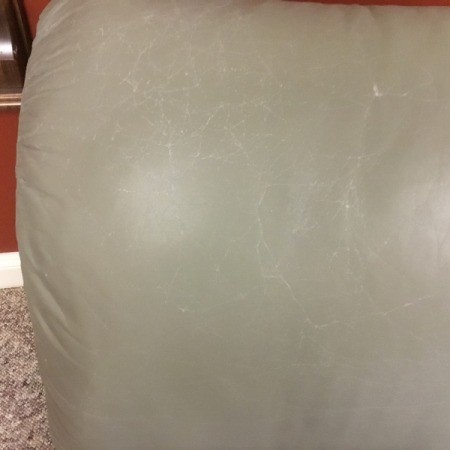
I'd try spray on vinyl
I bought a sofa second hand. I just needed one urgently and this was a cheap one. I was just wondering can I fix the tears and messed up sewing jobs?


Buy some pretty bed sheets and mattress pads (sew or safety pin the sheet to the mattress pad so the shredding isn't felt through whilst sitting on the sofa) to use as throw covers - to be frank, there is no saving this upholstery short of a complete reupholster job. Those seat repair kits are fab for small bits but it looks from your photos the entire seating area is shredded and no amount of kit repair is going to fix that.
I've got a faux leather sofa and a footstool, both require repairs to the stitching. I intend to do this by hand because I've never used a sewing machine; both are fairly small repairs; and I'm a complete novice to this so please help me with advice on how to repair these items and what with.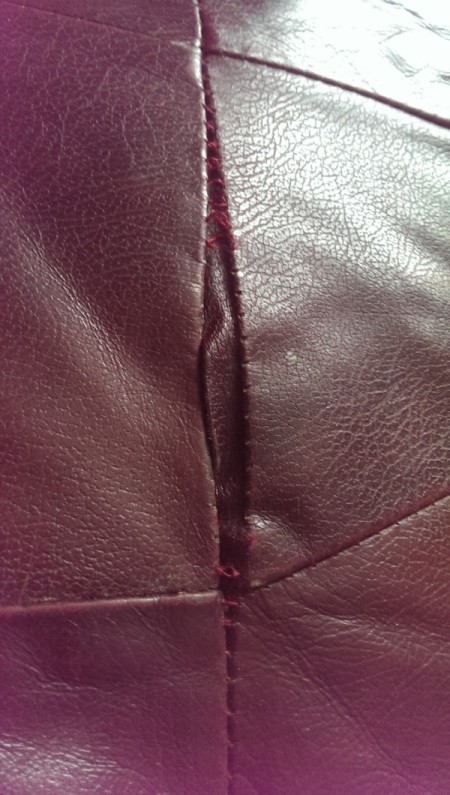
I've included photos, 1st is the sofa, and the other 2 are of the footstool. The colour of thread on both is different so I realise I'll need to purchase two different threads to minimise the obviousness of the repairs. I can actually get to the stitching on both from underneath, what needle and thread do I need?
I need to make both of these pieces of furniture last for some time into the future so your help and advice on a long lasting repair would be very much appreciated. I have some other up cycling projects in the pipeline, so I'll be a regular here looking for help and ideas!
Thanks a lot for your help and advice.
You need thick upholstery thread and 'circular' needles - they usually come on a card with other heavy duty needles, the ones you need are shaped like a half moon and I strongly urge you to practice using the needle and thread on some scrap fabric before trying to do your sofa as the circular needle is a bit tricky to handle at first. It is doable, it just take a half-hour or so of practice to become comfortable with. Also, buy a waxing wheel (should be on the same display area you'll find that card of needles) and wax your thread heavily before and after threading it through the needle. Be sure to cut the thread at least three times the length of your opened seam so you have enough to work with and fasten it off when you've closed the seam back down. If you pull the thread through your upholstery fabric in short lengths instead of trying to pull it all through at one time, you should be able to avoid tangles, and the heavy pre-waxing will help make untangling easier in case you do tangle up during the sewing.
Now, looking at your photos (excellent ones, I must add!), it looks as though you have a clear stitching path to follow once you have 'the hang' of the needle. Your 'path' is the line of holes in the fabric. Just bring your threaded and knotted (fat, tight. Trust me. I teach Sewing 101:) needle and thread up from under the 'raw edge' of the fold - look at the fold that should tuck under your stitching - see it in your 1st photo where the seam has come apart? Start your stitching there from under that folded bit - doing that will 'catch' your fat tight knot and anchor your stitching. Guide the needle up through the first hole, then across to the one directly opposite on the other side of the opened seam going in from under the fold on that side, then back over to the next hole on your starting side, then to the opposite one...and keep going until you reach the end of your opened seam.
Then pull it all tightly, test it for strength by poking and pushing the newly closed seam.
If it's strong enough to withstand wear, weave your needle through several of the exposed stitches then double back weaving over where you've just come from - do that at least three times, each time beginning the return one stitch shorter than the previous one. Now, this is the tricky part - you can either simply cut the thread and understand under wear it WILL work out and begin to unravel, or you can try tying a 'jeweller's knot' using a pair of slanted tweezers to work the knot down as close as possible to the seam. It will show eventually under wear but if you've got it tight enough, it shouldn't open.
This sort of repair is actually best done by removing the entire piece and using a heavy duty sewing machine - but you'll be happily surprised to find if you do it by hand the seaming won't be as obvious as you first think it is as long as you match the colours closely. Take a snippet of the existing thread, or your excellent photos to the shop so you get a good match.
Good luck - you CAN do this! Please post a photo of your finished repair and any tips you come up with to help the next upholstery repair newbie:)
Does anyone know how to repair or camouflage a melted cigarette burn in a white faux leather corner seat? Are there patch kits available? Thanks!
By freebyrdz
You used to be able to buy repair kits for vinyl in the hardware/automotive departments of discount stores, I don't know if they still have them, but it wouldn't hurt to look.
I have a medium/dark colored couch. On one end there are about five small cigarette burns on the arm rest. Also, where you sit, on the same side under this arm are about five holes. I keep the arms covered with clean, new dish towels, but I don't want to have to but a towel or something on the bottom. I actually want to fix it. I think this material is called faux leather.
By Judy from Memphis
You need to get a vinly repair kit from an autoparts store or amazon.com. They make an invisibe repair when used. Two year olds are tough so hide the lighter way up high next time!
Best of luck,
Tigra
I have a very dark brown recliner which has this very odd upholstery that I will call pleather. It looks like very soft leather, but is actually cloth with this thin layer of leather like look to it. I've had this chair for just over two years. All of a sudden it started blistering on the arm and on the back where one puts their head.
The blisters started to open up and peal away. I tried putting some electrical tape on it to cover the spot on the arm, but then that wouldn't stick for very long as people would sit in the chair and stretch the fabric. The chair belongs to my son. He really loves it.I'm trying everything I can to repair it the best way I can think, but I'm coming up with zilch. I thought perhaps upholstery tape may be the answer, but before I spend any more money, I thought I would ask one of your followers if they had encountered the same problem and what did they do about it?
By Sophia